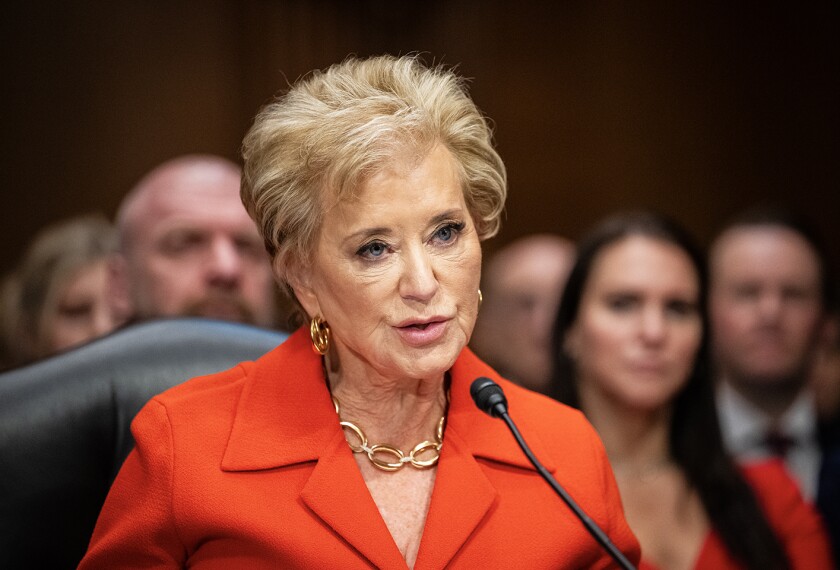Eschewing a Rose Garden ceremony, President Bush signed the new federal education act here last week at what could best be described as a heartland pep rally.
About 2,200 students, educators, and community members—including the school band blaring and a choir in full throat—packed the gymnasium at Ohio’s Hamilton High School on Jan. 8 to witness the event. And when Mr. Bush finally appeared, they showered him with sustained, almost deafening applause.
“Most bills are signed at the White House,” the president said, “but I decided to sign this bill in one of the most important places in America: a public school.”
Principal Tracey Miller, whose gym more typically hosts rival basketball teams, was beaming as he warmed up the crowd for the featured guest.
“Out of the tens of thousands of schools where this could have taken place, it’s taking place at Hamilton High School,” he said. “Ladies and gentleman, if this is our 15 minutes of fame, let’s use every second of it.”
Minutes later, Mr. Bush descended on the school grounds in a military helicopter.
The selection of Hamilton for the ceremony was no accident, of course. The town near Cincinnati falls within the congressional district of Rep. John A. Boehner, R-Ohio, the chairman of the House Education and the Workforce Committee. He played a leading role in shepherding the bill—the reauthorization of the Elementary and Secondary Education Act—through Congress.
Later that day, the president traveled for related events in New Hampshire and Massachusetts, the home states of Republican Sen. Judd Gregg and Democratic Sen. Edward M. Kennedy, respectively, two other lawmakers intimately involved in crafting the law. He followed up his whirlwind education caravan with a Jan. 9 rally in Washington.
The legislative process is done, the president said at Hamilton High, where a huge banner proclaiming “No Child Left Behind” on a fake chalkboard served as the backdrop. “And now it’s up to you, the local citizens of our great land ... to stand up and demand high standards, and to demand that no child—not one single child in America—is left behind.”
The law features new accountability provisions that were the centerpiece of the plan Mr. Bush proposed just after taking office a year ago.
The wide-ranging law authorizes about $26.5 billion in federal aid to schools. It places new pressure on states and districts to improve student achievement and close academic gaps between students of different racial, ethinc, and economic backgrounds. It also requires testing in mathematics and reading each year in grades 3-8.
The 9,200-student Hamilton City School District conducted lotteries to determine who would attend the event.
Hamilton has rarely seen the likes of a president. The last to visit the city was Harry S. Truman half a century ago.
Karen Blount, who teaches sophomore English at the high school, said she was not familiar with the details of the new law, but was especially pleased to hear Mr. Bush say it would offer more flexibility for districts in spending federal aid.
“I liked the fact that he kept emphasizing ... that there’s a lot of local control, because I think that is essential,” she said.
Not everyone was as upbeat about the new federal policy.
“I don’t know if I agree with everything in the bill,” said Cynthia A. Crane, a professor of English at the University of Cincinnati who attended public schools in Hamilton. “I think throwing money at schools and testing aren’t the answer.”
Matter of Trust
Mr. Miller, the Hamilton High principal, said he wasn’t worried about the burden the new rules might impose.
“We feel that we have done a lot of things that [President Bush] outlined in the bill,” he said. “We’ve had standards, we have accountability measures, and increase those standards every year.”
Holding the main event at Hamilton High was in some respects a curious decision because the expanded testing—a cornerstone of the Bush plan—would apply to earlier grades, not high school. And the flagship ESEA program, Title I, which provides money to help educate economically disadvantaged students, does not reach the school. However, Title I aid goes to many other schools in the district.
Hamilton High does receive some funds under a couple of other ESEA programs. About 45 percent of students districtwide participate in the free- and reduced-price lunch program.
But last week, the arcana of federal programs would not have dimmed the enthusiasm of the crowd assembled to see the president, whose popularity has soared since the terrorist attacks in September. Mr. Bush carried Rep. Boehner’s district by almost 2-1 over Vice President Al Gore in the 2000 presidential election.
Even with frigid temperatures and snow on the ground, visitors began lining up to enter the school hours before the event. Many others who couldn’t get tickets hung around outside to get a glimpse of Mr. Bush as he made his way from the chopper to the school.
Kevin Lloyd, a senior and an honor society student at Hamilton High School, was among the luckiest of the guests: He was onstage with President Bush.
“I was within 20 feet of the most powerful man in the world,” he said. “I think that’s pretty good.”
Asked about the new law that drew Mr. Bush to his school, he added: “All I know is it’s a huge education bill, twenty- six-point-something billion dollars, and it’s supposed to revolutionize education. It’s supposed to be great.”
Asked if he believed, as Mr. Bush declared, that the law will ensure that no child will be left behind, he said, “Honestly, I don’t know. I guess I’ll trust him.”




